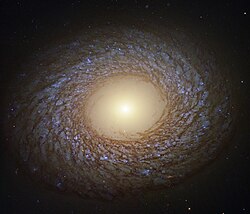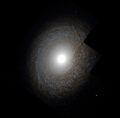Astronomy:NGC 2775
| NGC 2775 | |
|---|---|
 NGC 2775 as taken by Hubble Space Telescope | |
| Observation data (J2000 epoch) | |
| Constellation | Cancer |
| Right ascension | 09h 10m 20.112s[1] |
| Declination | +07° 02′ 16.53″[1] |
| Redshift | 1,316.4±13.4 km/s[2] |
| Distance | 67 Mly (20.5 Mpc)[3] |
| Apparent magnitude (V) | 10.4[4] |
| Characteristics | |
| Type | SAa[5] or SA(r)ab[6] |
| Apparent size (V) | 4.3′ × 3.3′[6] |
| Other designations | |
| UGC 4820,[7] PGC 25861,[8] Caldwell 48 | |
NGC 2775, also known as Caldwell 48, is a spiral galaxy in the constellation Cancer. It is 67 million light-years (20.5 megaparsecs)[3] away from the Milky Way. It was discovered by William Herschel in 1783. NGC 2775 belongs to the Antlia-Hydra Cluster[9] of galaxies and is the most prominent member of the NGC 2775 Group, a small galaxy group in the Virgo Super-cluster, along with the Local Group. Other members of the NGC 2775 Group include NGC 2777 and UGC 4781.[10]
This object has a morphological classification of SA(r)ab,[6] which indicates an unbarred spiral galaxy (SA) with a prominent ring structure (r) and flocculent,[11] tightly wound spiral arms (ab).[12] The galaxy is inclined by an angle of 44° to the line of sight from the Earth.[6] The galactic nucleus is not active[2] and the large nuclear bulge, which extends out to an angular radius of 0.4′,[12] is relatively gas free.[11] An explanation for the latter could be a high supernova rate.[6] Although star formation is taking place in the dusty outer ring,[12] NGC 2775 does not display any current starburst activity,[13] and the galactic nucleus is virtually free of any star formation whatsoever.[11]
The galaxy's hydrogen tail feature indicates a past interaction with a faint companion.[6] A satellite galaxy appears to have orbited NGC 2775 multiple times, losing mass as it does so and creating faint, shell-like structures.[12] Nearby irregular galaxy NGC 2777 displays a tidal tail of hydrogen gas that points back to NGC 2775, suggesting the two may be linked.[14]
SN1993z is the only supernova known to have occurred in NGC 2775. It was detected on September 23, 1993, at a magnitude of 13.9, and was classified as a Type Ia supernova.[15] By September 25, spectral analysis showed that it had peaked four weeks earlier.[16]
Gallery
NGC 2775 (SDSS DR14)
NGC 2775 from the Hubble Space Telescope
References
- ↑ Jump up to: 1.0 1.1 Skrutskie, Michael F.; Cutri, Roc M.; Stiening, Rae; Weinberg, Martin D.; Schneider, Stephen E.; Carpenter, John M.; Beichman, Charles A.; Capps, Richard W. et al. (1 February 2006). "The Two Micron All Sky Survey (2MASS)". The Astronomical Journal 131 (2): 1163–1183. doi:10.1086/498708. ISSN 0004-6256. Bibcode: 2006AJ....131.1163S. https://ui.adsabs.harvard.edu/abs/2006AJ....131.1163S/abstract.
- ↑ Jump up to: 2.0 2.1 van den Bosch, Remco C. E. et al. (May 2015). "Hunting for Supermassive Black Holes in Nearby Galaxies With the Hobby-Eberly Telescope". The Astrophysical Journal Supplement Series 218 (1): 13. doi:10.1088/0067-0049/218/1/10. 10. Bibcode: 2015ApJS..218...10V.
- ↑ Jump up to: 3.0 3.1 Cappellari, Michele et al. (May 2011). "The ATLAS3D project - I. A volume-limited sample of 260 nearby early-type galaxies: science goals and selection criteria". Monthly Notices of the Royal Astronomical Society 413 (2): 813–836. doi:10.1111/j.1365-2966.2010.18174.x. Bibcode: 2011MNRAS.413..813C.
- ↑ Finlay, Warren H. (2014). Concise Catalog of Deep-sky Objects. The Patrick Moore Practical Astronomy Series (2nd ed.). Springer Science & Business Media. p. 227. ISBN 978-3-319-03169-9.
- ↑ Ann, H. B. et al. (2015). "A Catalog of Visually Classified Galaxies in the Local (z ~ 0.01) Universe". The Astrophysical Journal Supplement Series 217 (2): 27–49. doi:10.1088/0067-0049/217/2/27. Bibcode: 2015ApJS..217...27A.
- ↑ Jump up to: 6.0 6.1 6.2 6.3 6.4 6.5 Hogg, David E. et al. (March 2001). "Hot and Cold Gas in Early-Type Spirals: NGC 3623, NGC 2775, and NGC 1291". The Astronomical Journal 121 (3): 1336–1357. doi:10.1086/319400. Bibcode: 2001AJ....121.1336H.
- ↑ "NGC 2775". SIMBAD. Centre de données astronomiques de Strasbourg. http://simbad.u-strasbg.fr/simbad/sim-basic?Ident=NGC+2775.
- ↑ "NASA/IPAC Extragalactic Database". Results for NGC 2775. http://nedwww.ipac.caltech.edu/.
- ↑ O'Meara, Stephen James; Moore, Patrick (2002). The Caldwell objects (2nd ed.). Sky Publishing Corporation. p. 192. ISBN 0521827965. https://books.google.com/books?id=3Hg6YHgx9nAC&pg=PA192.
- ↑ "A List of Nearby Galaxy Groups". Atlas of the Universe. http://www.atlasoftheuniverse.com/galaclus.html.
- ↑ Jump up to: 11.0 11.1 11.2 "Hubble Spots Feathered Spiral". NASA. 2020-07-02. https://www.nasa.gov/image-feature/goddard/2020/hubble-spots-feathered-spiral.
- ↑ Jump up to: 12.0 12.1 12.2 12.3 König, Michael; Binnewies, Stefan (2017). The Cambridge Photographic Atlas of Galaxies. p. 35. ISBN 978-1107189485. https://books.google.com/books?id=JY0wDwAAQBAJ&pg=PA35.
- ↑ Shapiro, Kristen L. et al. (December 2003). "Observational Constraints on Disk Heating as a Function of Hubble Type". The Astronomical Journal 126 (6): 2707–2716. doi:10.1086/379306. Bibcode: 2003AJ....126.2707S.
- ↑ Arp, Halton; Sulentic, Jack W. (July 1991). "The Properties of NGC 2777: Are Companion Galaxies Young?". Astrophysical Journal 375: 569. doi:10.1086/170218. Bibcode: 1991ApJ...375..569A.
- ↑ "List of Supernovae". IAU Central Bureau for Astronomical Telegrams. http://www.cbat.eps.harvard.edu/lists/Supernovae.html.
- ↑ "IAUC 5870: N Lup 1993; 1993Y; 1993Z". IAU Central Bureau for Astronomical Telegrams. http://www.cbat.eps.harvard.edu/iauc/05800/05870.html.
External links
- NGC 2775 on WikiSky: DSS2, SDSS, GALEX, IRAS, Hydrogen α, X-Ray, Astrophoto, Sky Map, Articles and images
- NGC 2775 at Deepskypedia
 |





